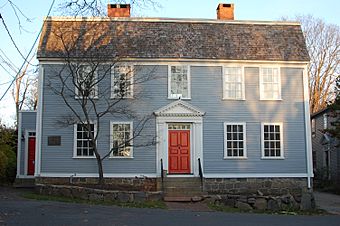General John Glover House facts for kids
The General John Glover House is a really old and important house in Marblehead, Massachusetts. It was built in 1762 by John Glover. He was a local businessman and a brave leader during the American Revolutionary War. This house is special because John Glover lived here during the war. It's even called a National Historic Landmark because of its connection to him.
|
General John Glover House
|
|
|
U.S. Historic district
Contributing property |
|

General John Glover House, 11 Glover Street
|
|
| Location | Marblehead, Massachusetts |
|---|---|
| Area | less than one acre |
| Built | 1762 |
| Part of | Marblehead Historic District (ID84002402) |
| NRHP reference No. | 72001101 |
Quick facts for kids Significant dates |
|
| Added to NRHP | November 28, 1972 |
| Designated CP | January 10, 1984 |
Contents
About the General John Glover House
The Glover House is a two-and-a-half-story building made of wood. It has a special kind of roof called a gambrel roof, which has two slopes on each side. There are two chimneys inside the house, placed evenly. A two-story kitchen part sticks out from the back.
Inside the Historic Glover Home
The front door faces west and is in the middle of the house. Above the door, there's a window with four small panes of glass. The doorway is decorated with flat columns called pilasters and a triangular shape called a pediment.
Inside, the house has a layout similar to many old homes. There's a large living room on the right side. On the left, there's a smaller dining room. Behind the dining room, a hallway leads to another staircase and a side door. Both the living room and dining room have fancy carvings around their fireplaces. The living room also has decorative molding at the top of the walls. Upstairs, you'll find three bedrooms.
Who Was General John Glover?
John Glover was born in Salem, Massachusetts in 1732. He moved to nearby Marblehead when he was young. He became a successful businessman and was quite wealthy.
Glover's Early Life and Military Start
In 1759, John Glover joined the local militia, which was like a volunteer army. In 1762, he built this house, and it was his home until 1782. By the time the American Revolutionary War began in 1775, Glover was already involved in resisting British rule.
Glover's Role in the Revolutionary War
Glover quickly became very important in the Continental Army. He was especially good at moving troops and supplies by water. This was very helpful during the New York and New Jersey campaign in 1776 and 1777.
One of his most famous actions was on August 29–30, 1776. After the Americans lost the Battle of Long Island, their army was trapped. Glover bravely managed to move all the Continental forces across the water to safety without losing many soldiers.
He was also a key part of George Washington's famous crossing of the Delaware River. This happened on the night of December 25–26, 1776. This crossing led to a big American victory at the Battle of Trenton.
Promotions and Later Life
After these important actions, John Glover was promoted to brigadier general. He then led a group of soldiers in the Battles of Saratoga in September and October 1777. These battles were a major turning point in the war. At the end of the war, he received another special promotion to major general.
In 1782, Glover bought a new estate in Marblehead. This property had belonged to William Browne, who was a Loyalist (someone who supported the British during the war). The state had taken Browne's property. Glover lived at this new farm until he passed away in 1796. The old farm house still exists today, but it has been changed a lot over the years.
John Glover continued to be active in his local community. He also served in the Massachusetts meeting that approved the United States Constitution in 1788.
Historic Recognition of the House
The General John Glover House was recognized as a National Historic Landmark in 1972. It was also added to the National Register of Historic Places that same year. Later, in 1984, it was included as part of the larger Marblehead Historic District.



